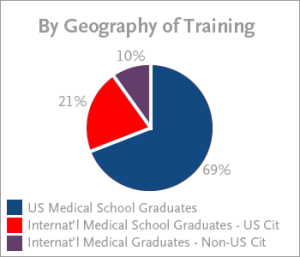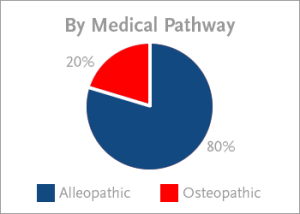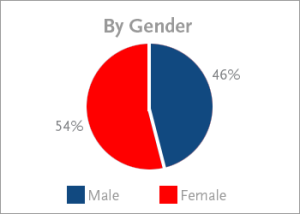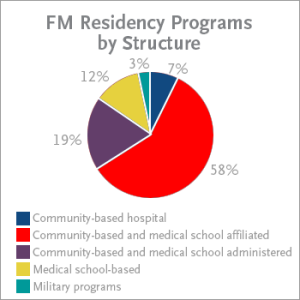Best Family Medicine Residency Programs in the Us
If yous are a medical educatee who has decided on a career in family medicine, you will demand to weigh your residency program options carefully — the right choice may not be the obvious one. Plan location, ranking, educational rigor, opportunities to specialize, and other factors will affect your futurity, so you must consider all facets thoughtfully. We'll talk over several of import components of choosing a family medicine residency programme in this post, but kickoff, here are several useful resources from the AAFP to get you started:
- Download — and read cover to cover — the gratuitous comprehensive guide by the American University of Family Physicians (AAFP), Strolling Through the Match.
- Register with the American Medical Association'southward FREIDA Online® database service, which enables y'all to search and access data on some 9800 ACGME-accredited graduate medical pedagogy programs and more 100 combined specialty programs. FREIDA Online® enables clear comparisons of multiple programs and, for AMA members, a dashboard feature empowers residency candidates to rate, track, and manage programs to which they are interested in applying.
- Plan to attend the AAFP's National Briefing, which is held each summer in Kansas City and provides a cost- and time-effective opportunity to touch base with hundreds of family medicine residency programs all in one identify.
There are an affluence of helpful online resources to assist imminent med-school graduates in navigating the complex — and rather grueling — Electronic Residency Application Service (ERAS) and National Residency Matching Program (NRMP) processes. Here are some of the bigger, more nuanced aspects of evaluating family medicine residency programs.
Likelihood of Being Matched to a Family unit Medicine Residency Program
Co-ordinate to statistics published by the NRMP and reported by the AAFP, some 3060 graduating medical students chose careers in family medicine in 2015, representing a sixth consecutive yr of growth for the field. At the same fourth dimension, some 3216 family medicine residency positions were offered, significant 95.1% of bachelor positions were filled. While the fill rate in 2015 was downwardly slightly from 2014, there was an absolute increase of 84 positions, with some sixty boosted medical graduates accepting positions in family unit medicine residency in 2015 compared with final year.
In July 2014, the AAFP reported that 477 accredited family medicine residency programs hosted a g total of 10,662 first through third-yr residents:



Growth in the number of U.S. medical schoolhouse graduates choosing family medicine slowed at an unexpected rate in 2015, totaling 1422, with only six boosted U.S. medical school graduates selecting family medicine compared with the full number of U.Due south. students in 2014. With some 2.3 family medicine residency positions available per interested U.S. medical schoolhouse graduate, virtually U.South. students with solid academic records can expect to be matched to programs that accommodate both their needs and career aspirations.
Finding the Plan For Y'all
There is no U.S. News & World Report-style ranking of family unit medicine residency programs to use as a starting point in program search. Indeed, it would be well-nigh impossible to produce such a report because there are far also many personal variables involved in evaluating family medicine residency programs. Your first round of selections — where to apply and interview — will likely depend on answers to such questions as:
- Where yous want to alive
- What type of customs you lot wish to serve — urban, suburban, rural, underserved, or military
- Whether you are interested in pursuing a combined specialty — such as combining family medicine with emergency medicine, obstetrics, psychiatry, or preventive medicine
Ranking prospective family medicine residency programs for the match will rely on a much more than comprehensive listing of decision factors. Indeed, an evaluation guide offered as function of the AAFP'due south Strolling Through the Match publication includes some lx program attributes to consider scoring every bit y'all progress through the interview procedure. Meanwhile, a mobile app designed to aid with program rating and ranking offered past the Section of Family unit Medicine at the University of Wisconsin School of Medicine and Public Health includes nearly ninety preset attributes that you might wish to consider — with opportunities to add your own custom attributes as well.
While we can't cover every point of consideration in detail here, we will endeavour to accost major buckets into which most of the primal program attributes sort.
Educational Rigor and Value
Consider the following factors related to programs' educational rigor, breadth, and overall value:
- Plan accreditation and philosophy
- Rotations
- Rounds
- Conferences and seminars
- Faculty dedication to educational activity (vs. research and other professional person obligations)
- Constituent opportunities
- Exposure to subspecialties
- Variety of clinical settings
- Libraries and other resources available to residents
Different program structures may yield dramatically different educational experiences, though how yous value those experiences is entirely subjective and ofttimes a function of where and how you hope to practice medicine. The latest bachelor statistics for family medicine residency program structure (equally of July 2013 and reported by AAFP) are as follows:

While you might assume programs affiliated, administered, or run by medical schools to exist more educationally rigorous or diverse, this is non e'er the case. Medical school faculty may exist spread too thinly or have multiple competing obligations, such as research pursuits taking their attention away from pedagogy residents.
At the other end of the spectrum, community-based hospital residency programs may find information technology challenging to consistently deliver relevant, high-quality seminars and lectures. Customs affiliate programs may also present serious logistical difficulties for residents who are forced to travel – on tight schedules – to accept part in mandated lecture, conference, and seminar activities at secondary locations.
If you are evaluating unaffiliated community-based hospital residencies, it will be important to define the commitment of staff physicians to supporting the program. Other decision factors may include:
- Opportunities for interprofessional collaboration with nurse practitioners, pharmacists, dieticians, physiotherapists, social workers, and mental wellness therapists
- Proportion of pedagogy versus so-called scut piece of work
- Board certification rates of plan graduates, which can exist investigated online
Either way, it is uncommonly important both to define what yous want from future practice and — in that context only — gain full understanding of potential educational value in each program. Those conducting official interviews volition effort to sell their programs to you as a candidate, so it is also important to seek out and talk with people who accept gone through your prospective programs in the recent past, preferably nether incumbent plan leadership.
Competing Specialties May Influence What You Learn and Don't Learn
A huge decision factor for family medicine residency applicants volition be whether to enter a program that is "opposed" or "unopposed" by other medical specialties. With finite numbers of cases in given fourth dimension periods, each medical establishment must classify cases and opportunities to learn and practice specific medical procedures. That allocation can be biased in favor of competing specialties, such as internal or emergency medicine, especially with respect to procedures that PCPs will rarely (if ever) exist expected to perform in clinical do.
Although family medicine residents working in opposed programs sometimes study beingness treated as second-class citizens, they also capeesh the greater diversity of academic content and opportunities to interact regularly with residents in other specialties. By dissimilarity, those entering unopposed family unit medicine residency programs frequently say they receive greater personal attention from faculty, simply — because they are the merely residents available — may cease upwards doing rotations and procedures that autumn exterior their areas of interest.
Where you intend to practice medicine over the longer term volition be a key gene in deciding between opposed and unopposed programs. For instance, a medical student intending to practise family medicine in an isolated rural setting might opt to complete residency in an unopposed, busy urban setting that volition expose him or her to the greatest possible variety of patients, cases, clinical diagnoses, and procedures in grooming for practicing in relative isolation. If, on the other mitt, a educatee is aiming to work long-term in a large, suburban chief intendance practice with aplenty opportunities to consult with other physicians and specialists, he or she might exist content to train in an opposed program that emphasizes skills related to preventive care and patient interaction versus procedures they are unlikely to ever undertake.
Program Competitiveness and Reputation
Onetime residents' online reviews of family unit medicine residency programs can exist quite interesting and instructive to read, just you should view them with some caution. Some may exist years old and, therefore, not reflective of electric current program leadership and structure. While some negative reviews may be perfectly valid and worth investigating further, others may exist just sour grapes in a world where information technology is altogether too easy to take to the internet with bearding comments.
Additionally, because this is a field with more than open positions than candidates, some family medicine residency programs will choose to fill openings with foreign students (non-U.South. citizens attending non-U.S. medical schools) or international students (U.S. citizens attending medical school abroad). You may discover undertones of prejudice against the competitiveness of these programs in online reviews, only you should look past such simplistic assessments considering U.S. family medicine residency programs often attract top students from highly rigorous foreign medical schools, and these students bring welcome diversity in terms of medical cognition and sensitivity to cultural nuances in patient populations, as well every bit many other benefits that tin enrich your preparation.
It is far better to spend time conversing with acting residents too as recent program alumni earlier making snap judgments about program competitiveness and reputation. When traveling for interviews, attempt to brand contact with program alumni who are not office of the official interview squad. Other people to check in with around program competitiveness and reputation include your own medical schoolhouse faculty and physicians working in desired practise settings.
Personal Happiness
Factors begetting on personal happiness — piece of work hours, phone call schedules, patient loads, salary vs. cost of living, perks, benefits, surrounding community, and so forth may have less influence than academics on your ultimate competence every bit a primary care doctor. Notwithstanding, they still demand to be incorporated into any counterbalanced rating or scorecard system to assist with ranking family unit medicine residency programs comprehensively for the match.
Ranking Your Options
Medical students going into family medicine residencies should develop their own proprietary weighted models for scoring programs beyond a uniform prepare of criteria. This volition allow you to draw clear comparisons and note winners and losers for friction match-ranking purposes. This weighting will exist subjective as each person and each family values different things. While location may affair strongly to 1, breadth of training may matter greatly to some other. Yous will need deep introspection and honesty to develop the best personal model for you.
Regardless of how competitive a programme may seem and where you lot place your own chances of being matched, e'er rank your preferred programs first. While the matching algorithm is circuitous (and a bit mysterious), it is known that student rankings of programs always prevail over program rankings of students. This means there is always a possibility that even highly competitive family unit medicine residency programs will not fill all open up positions with their top-ranked student choices. Because total positions outnumber student applicants in family medicine, you e'er accept a chance of matching to a preferred program.
At the same time, the match is a contractually bounden process, so, while information technology is important to rank plenty programs to better your probability of matching, never rank a programme y'all definitely do not want. If, every bit in rare cases, you do not match, you may still exist able to scramble into a program that falls lower on your ranked list.
Here are some additional recommendations to get you lot started as yous explore the family medicine residency program options:
- AAFP – Choosing a Residency Program
- AAFP Residency Directory
- American Medical Association FREIDA Online® — Your Source for Residency Programme Data
- American Lath of Family unit Medicine – Residency Program Examination Pass Rates
Comments are closed.
Source: https://knowledgeplus.nejm.org/blog/family-medicine-residency-programs-choosing-the-right-one-for-you/

0 Response to "Best Family Medicine Residency Programs in the Us"
Post a Comment